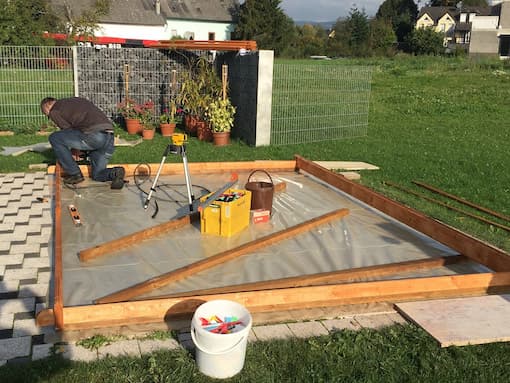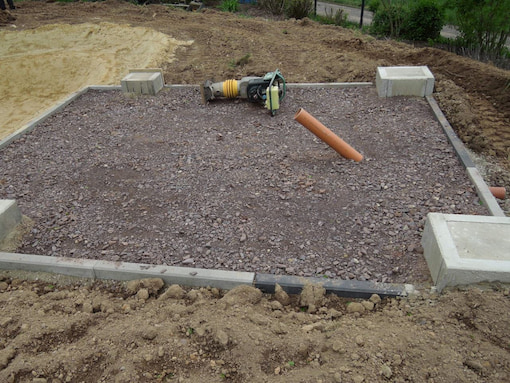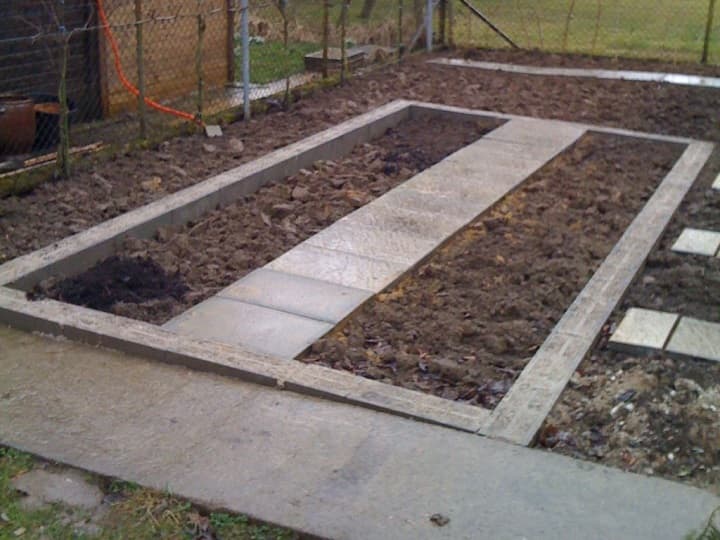Last updated on October 23rd, 2023 at 09:04 pm
Whether as a storage facility for bicycles and garden furniture, for overwintering plants or as a year-round recreation room – a garden shed can be used in many ways. In order for you to enjoy your own summerhouse for as long as possible, the foundation must also be right. Otherwise, your cottage will not stand securely and damage to the house may occur. We explain which type of foundation is suitable for which garden shed, give tips for planning and explain step by step how to build the foundation.
Why do you need a garden shed foundation?
You can’t do it without a foundation! Because without the right foundation for your garden shed, your cottage will not stand securely. Especially in heavy rain, soggy ground or heavy ground frost, the garden house can then become unstable, walls warp and cracks appear. Consequence: the joy of the garden house does not last long. But don’t worry, a concrete slab does not have to be poured for every garden house. Depending on the size, weight and material of your garden house, a slab or point foundation is quite sufficient.
Build foundation yourself: What to consider?
Building a foundation for your garden shed can be done well in a do-it-yourself project – even by non-professionals. But like any construction project, building a foundation should be well planned and prepared. After all, once the foundation is poured and the garden shed is built on top of it, it is very difficult to fix mistakes afterwards.
Tip:
Also plan any water and power lines right from the start. So you should definitely consider the following points during the planning:
The type of foundation depends on the size and weight of the garden shed:
Not every foundation is suitable for every garden house size. Small and light metal houses can be placed on a foundation of paving slabs without any problems. A heavy, large log house on the other hand, should definitely be erected on a poured concrete foundation, as here the load of the garden house is ideally distributed over the entire concrete surface.
Sidewalk slabs
The type of garden shed depends on the soil conditions:
Not every soil is suitable for every type of garden shed. To ensure that the foundation will support the load of the garden shed and not cave in or sag, be sure to match the foundation to the condition of the garden soil. A hard, stable soil will withstand the heavy loads of a heavy garden shed better than a very soft soil. If the ground is yielding, a foundation should be poured.
The foundation should always be larger than the footprint of the garden house:
The foundation should always be slightly larger than the planned cottage. This gives you a small buffer so that the garden house does not overhang in the end. It also gives the entire structure extra stability, supports the house and thus ensures that it does not break away or sag.

It is essential that the ground be level:
A firm stand for the foundation and garden house is only given if the ground is absolutely level. If necessary, you must first level the surface or, if necessary, fill it in to compensate for unevenness. Only then can you build the foundation.
A frost apron protects against frost damage:
A so-called frost apron is recommended especially for large, heavy garden sheds. This is a strip filled with concrete that runs around the concrete foundation of the garden shed and is excavated to the frost-free soil depth of about 80 cm. This ensures that any ground frost does not deform and damage the foundation and thus the garden shed structure.
Foundations differ primarily in terms of labor and cost, which depends primarily on the type of foundation and the materials used. Also, whether you get help from a specialist or implement the whole thing yourself, of course, has an impact on the total cost of the construction project. In principle, however, you should expect costs of between 500 and 5,000 euros for a foundation of 5 × 5 m – depending on the type of foundation (craftsmen’s costs excluded).
Tip:
If you are pouring a concrete slab, strip foundation or point foundation, you will need the ideal concrete. You can mix this yourself inexpensively or use ready-mixed concrete (approx. 20 cents/kg) from the DIY store. In any case, you will need a concrete mixer. You can borrow one for a few days at a hardware store. If you do not want to mix the concrete yourself, you can of course have it delivered, but this is more expensive than mixing it yourself.
Contents
How to build your foundation
Have you decided on the right foundation? Great! We explain step by step how to build each type of foundation:
Slab foundation with sidewalk slabs
Excavate the ground to a depth of about 30-35 cm and straighten the surface. A level surface is extremely important for the garden house to stand securely later.
This is followed by a layer of gravel approx. 25 cm thick, which you compact in the next step (ideally with a vibratory plate).
This is followed by approx. 5 cm of gravel. Pull off this surface to level it.
The sidewalk slabs now follow, finishing with the turf.
Grout the joints between the individual slabs with sand, e.g. quartz sand.

Tip:
Also plan for any water and power lines right from the start. The following points should therefore be taken into account during planning:
Point foundation
Level the ground
Mark the footprint of your future garden shed and align the foundation points with it. Important: The foundation points must be placed under the supporting elements of the garden house.
In the next step, use a spirit level to make sure that the points are level. This step is extremely important so that the garden house later stands straight and secure.
Now dig 80 × 20 cm deep holes and fill them with concrete.
After the concrete has hardened, fasten the garden house beams with concrete anchors or angled hooks.
The spaces between the individual foundation points should be filled with gravel. This will prevent water from accumulating under the garden shed, which could lead to moisture damage to the shed.
Alternative variant: point foundation made of variable brackets or plinths.
Mark the base of the garden house and excavate it to a depth of about 20 cm.
Cover the area with PE film.
This is followed by a layer of gravel, which you level.

Place the base supports under the load-bearing elements according to the construction plan of the house.
Now fix the foundation timbers.
On this construction you will then fix the frame of your garden house.
Strip foundation
Mark the outline of your garden house.
Now dig an 80 × 30 cm deep trench all around.
Fill the trench of the strip foundation with concrete.
Fill the intermediate area with gravel. Alternatively, you can pave the area or even build a concrete slab. This way you will prevent moisture damage to the garden shed.
Excavate the base plus perimeter buffer to a depth of about 30-40 cm. Also dig the trench for a possible frost apron.
Pull the surface smooth and compact it.
Install the casing boards. Alternatively, use basement wall blocks that are poured with concrete.
Fill the area with about 15 cm of gravel and compact the area again.
This is followed by a PE film, which will later protect the garden house from moisture.
Fill in about 5 cm of concrete and lay out a structural steel mat.
Now again follow with a 10 cm layer of concrete and a structural steel mat.
Now fill the entire casing and pull the concrete surface smooth.
Tip:
A do-it-yourself project should first and foremost be fun and, of course, produce a satisfactory result in the end. However, building some of the foundation types mentioned above requires some craftsmanship. Therefore, it can be quite helpful to get advice or help from a professional. This way you can avoid mistakes and make sure that your foundation is resilient and safe.
Frequently asked questions
Here you will find answers to questions we are frequently asked.
How deep does a foundation for a garden shed need to be?
Depending on the type of foundation you choose, the soil must be dug to different depths: For a simple slab foundation, it is sufficient to dig the soil to a depth of 25-30 cm, for a strip or point foundation it must be around 80 cm, and for a poured concrete slab, the soil should be excavated to a depth of about 30-40 cm.
How to pour a foundation?
First, excavate the base of the garden shed plus a 10 cm buffer all around to a depth of about 30-40 cm. This area you pull smooth and compact it.
Now attach the casing boards around the outside. These make it easier to pour in the concrete and keep it in shape.
Now follow with about 15 cm of gravel. This layer is also compacted.
This is followed by a special PE film, which will later protect the garden house from moisture.
Fill a thin layer of concrete and put a structural steel mat on top. Repeat this step.
Fill in the rest of the concrete and pull the surface smooth. After the slab hardens, you can erect your garden shed.
How deep does a foundation for a garden shed need to be?
Depending on the type of foundation you choose, the soil must be dug to different depths: For a simple slab foundation, it is enough to dig the soil to a depth of 25-30 cm, for a strip or point foundation it must be around 80 cm, and for a poured concrete slab, the soil should be excavated to a depth of about 30-40 cm.
What foundation for garden shed?
The type of foundation depends mainly on the size and weight of the garden shed, as well as the soil conditions. For a light metal garden shed on load-bearing soil, a slab foundation is sufficient. For a large, heavy wooden garden shed on soft soil, a concrete slab should be poured.
What is the cost of a foundation for a garden shed?
The cost of a foundation is quite individual. They depend, on the one hand, on the type of foundation and the materials used, and on whether you have the work done by a professional or build the foundation yourself. For a 5 × 5 m foundation area, you should expect to pay between 500 and 5,000 dollars, depending on the type of foundation.
When is a foundation necessary?
We recommend in any case to build a foundation for your garden house. The type of foundation depends primarily on the size and weight of the garden shed and the nature of the soil on which it is to stand.


